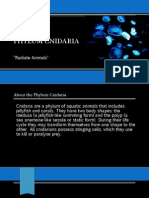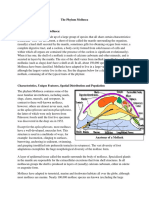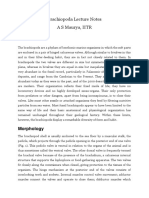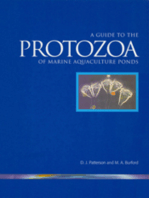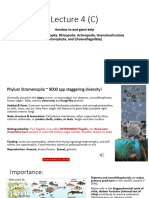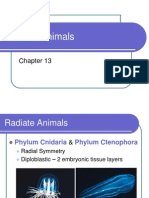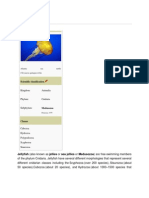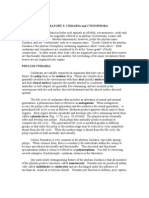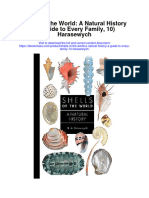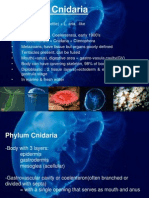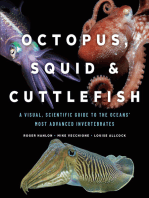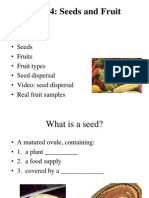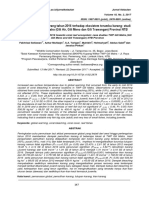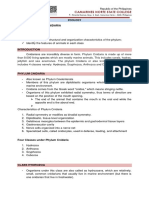Professional Documents
Culture Documents
Introduction To The Hydrozoa NEW!
Uploaded by
Syarif Hidayat AmrullahOriginal Description:
Original Title
Copyright
Available Formats
Share this document
Did you find this document useful?
Is this content inappropriate?
Report this DocumentCopyright:
Available Formats
Introduction To The Hydrozoa NEW!
Uploaded by
Syarif Hidayat AmrullahCopyright:
Available Formats
From: http//www.ucmp.berkeley.edubacteriacyanosy.html 1.
Introduction to the Hydrozoa
2. 3. 4. 5.
Hydrozoa: Fossil Record Hydrozoa: Life History and Ecology - Introduction to the Chondrophorina Hydrozoa: Systematics Hydrozoa: More on Morphology
BIOLOGY Makassar State University
Introduction to Hydrozoa
Pelagiat: Syarif BIO 07
Pelagiat ini adalah seorang mahasiswa biologi sok tahu dan paling gak aktif di Universitas Negeri Makassar. Berbekal kemampuan membajaknya ia telah membuat sejumlah karya (sebenarnya cuma meng-copy) tentang materi kuliah Pendidikan Biologi semester III. Tak ada lain dan tak ada maksud selain mencoba membantu mahasiswa dalam memperluas pengetahuannya, tidak hanya mendapat info dari diktat warisan dan transparansi berjamur. Hidup internetan gratis!!
HYDROZOA Copied from httpwww.ucmp.berkeley.edubacteriacyanosy.html
BIOLOGI FMIPA UNM
Penerbit Suka-Suka Gue
HYDROZOA Copied from httpwww.ucmp.berkeley.edubacteriacyanosy.html
BIOLOGI FMIPA UNM
Intoduction to the Hydrozoa
Perhaps the best-known hydrozoan, familiar to most students of introductory biology, is Hydra, pictured at left. Hydra never goes through a medusoid stage and spends its entire life as a polyp. However, Hydra is not typical of the Hydrozoa as a whole. Most hydrozoans alternate between a polyp and a medusa stage they spend part of their lives as "jellyfish" which are hard to distinguish from scyphozoan jellyfish. A great many hydrozoans are also colonial. Some form delicate branched colonies, while others, known as "fire corals," form massive colonies that resemble true corals. Other hydrozoans have developed pelagic (floating) colonies that are often confused with jellyfish, but unlike jellyfish they are composed of many individuals, all specialized for various functions. The "Portuguese mano'war" and "by-the-wind-sailors" that often wash up on beaches are examples of these unusual colonial hydrozoans.
Hydrozoa: Fossil Record
HYDROZOA Copied from httpwww.ucmp.berkeley.edubacteriacyanosy.html Hydrozoans may date back to the Vendian (late Precambrian), but the fossil record of hydrozoans is scanty before the Cenozoic, starting about 65 million years ago. The oldest fossil milleporines and stylasterines the "fire corals," so called from their stony growths that resemble those of true true corals appeared in the Late Cretaceous and are moderately common as fossils in the Cenozoic. Other hydrozoan groups may secrete chitinous exoskeletons (periderm) that may
BIOLOGI FMIPA UNM
occasionally be preserved as fossils. A rare fossil hydroid, Mississippidendrium from the Cretaceous of northeast Mississippi, is shown at the top of the page. Note the branches with thecae, or cups, on the ends, which would have surrounded the bases of the polyps in life. The chondrophorines, or "by-the-wind sailors," float by means of an internal chitinous float, which may occasionally be preserved as a fossil impression. The earliest chondrophorines may be Vendian forms like Eoporpita.
Hydrozoa: Life History and Ecology
With about 2700 species, the Hydrozoa are a fairly diverse group, but they usually receive little notice, because many species form small branched colonies that can be mistaken for seaweed. Such colonial hydrozoans may be found attached to rocks or other hard substrates. Some colonies encrust hard substrates, while others form little feather-shaped or bushlike erect colonies. The members of one hydrozoan genus in particular, Hydractinia, form dense crusts on shells occupied by hermit crabs, and apparently defend the crab from predators. Other colonial hydrozoans, such as the chondrophorines and siphonophorans, are pelagic; many of these have developed internal gas-filled floats as an aid to buoyancy. Some siphonophores may reach lengths of over a meter and migrate up to 300 meters vertically in the water column in an hour. Most hydrozoans are marine, but hydrozoans also include the few cnidarians that have adapted to fresh water: these are the polyps in the genus Hydra and a few species of small freshwater jellyfish.
HYDROZOA Copied from httpwww.ucmp.berkeley.edubacteriacyanosy.html
BIOLOGI FMIPA UNM
Introduction to the Chondrophorina
It looks like a jellyfish but it isn'tPorpita, shown here, isn't even a single organism, but a colony! The central disc is reinforced with a chitinlike material and is chambered in cross-section; filled with gas, it keeps Porpita afloat, for these are pelagic creatures. The "tentacles" of Porpita are in fact individual zooids, each of which is specialized for a particular function, such as digestion, prey capture, or reproduction. Porpita is a member of a small but very widespread group of hydrozoan cnidarians, the Chondrophorina. There are only two accepted genera of chondrophorines, Porpita, shown above; and
Velella, which resembles Porpita but has a keel-like "sail" on its aboral surface. Both often wash up on beaches in huge flotillas of thousands of organisms. Chondrophorines were once classified with another unusual group of hydrozoans, the siphonophores. The most famous siphonophore is Physalia, the so-called "Portuguese man-o' war." Like Porpita, siphonophores somewhat resemble jellyfish but are actually colonial organisms, with different individuals specialized for different functions; most, but not all, have a gas- filled float.
HYDROZOA Copied from httpwww.ucmp.berkeley.edubacteriacyanosy.html
BIOLOGI FMIPA UNM
Hydrozoa: Systematics
Traditional systematics divides the Hydrozoa into five orders:
Trachylinida Small medusae with no polyp generation; medusae develop directly from a crawling larva known as an actinula. Trachylines are very rare as fossils. Hydroida Mostly colonial forms with alternating polyp and medusa stages and a chitinous exoskeleton. A few, such as Hydra, are solitary polyps that lack a medusoid stage. The chondrophorines are now usually classified in the Hydroida; formerly they were placed with the Siphonophorida (see below). Milleporina and Stylasterina Colonial forms with massive skeletons of aragonite (calcium carbonate). These two orders differ in details of skeletal construction and dactylozooid (prey-gathering polyp) morphology. Sometimes grouped together as the Hydrocorallina, and known as "fire corals" for their coral-like growth and their painful sting. Siphonophorida Complex colonial forms, with individual polyps specialized for feeding, swimming, prey capture, and reproduction. Some but not all float by means of a large pneumatophore, or gas bag. The best-known siphonophorid is Physalia, the stinging "Portuguese man-o'-war." Siphonophores are unknown as fossils.
HYDROZOA Copied from httpwww.ucmp.berkeley.edubacteriacyanosy.html
BIOLOGI FMIPA UNM
Hydrozoa: More on Morphology
Most hydrozoans show the same alternation between polyp and medusa phases that the Scyphozoa, or "true" jellyfish, have. A fertilized egg develops into a sessile polyp, which buds asexually and eventually buds off one or more medusae. The medusa produce eggs and sperm, reproduce sexually, and thus the cycle is repeated. The difference between most hydrozoans and most scyphozoans is that in hydrozoans, the polyp stage usually predominates, with the medusa small or sometimes absent. Often, the medusa never breaks away from the parent polyp, and remains in a state of arrested development, although its gametes function. Such a medusa is referred to as a sporosarc. In scyphozoans, the medusa stage is typically large and free-living, with the polyp stage small. However, there are exceptions certain hydrozoans known as the Trachylina never form a polyp stage. Free-living medusoid hydrozoans can be hard to tell from scyphozoans, but hydrozoan medusae generally have a muscular shelf, or velum, projecting inward from the margin of the bell. This structure is not found in scyphozoans. Hydrozoans also lack cells in the mesoglea, the jelly layer found between the basic cell layers, whereas scyphozoans contain amoeboid cells in the mesoglea.
Another feature that is quite common in Hydrozoa but not typical of Scyphozoa is colonial organization. While a few hydrozoans, such as Hydra, are solitary polyps, most live in colonies made up of anywhere from a few to thousands of individual polyps. Colonies may secrete extensive calcium carbonate skeletons (coenosteum) or be covered with a flexible chitinous exoskeleton (perisarc). In colonial hydroids, the individual polyps, or zooids, are differentiated for different functions: gastrozooids feed, dactylozoids capture prey, and gonozooids give rise to medusoids with gametes. Some colonial hydrozoans are so integrated that they behave like a single animal and are often mistaken for jellyfish. The "by-the-wind-sailors," or chondrophorines, are such colonial hydroids. Even more integrated are the siphonophores, which not only bear feeding and reproductive zooids but often nectophores, or pulsating swimming bells, and/or pneumatophores, or gas-filled floats. Shown above left is a beached siphonophore, Physalia utriculus, known as the "Blue Bottle." It is a close relative of the "Portuguese man-o'-war" (Physalia physalis); the gas float is at the top, with one long feeding tentacle hanging below.
You might also like
- HydrozoaDocument3 pagesHydrozoaBercia MondialuNo ratings yet
- Monoplacophorans: Sea Slugs, Squid, Snails, and ScallopsDocument4 pagesMonoplacophorans: Sea Slugs, Squid, Snails, and ScallopsCoevicNo ratings yet
- Intro CnidariaDocument2 pagesIntro Cnidariaapi-303098361No ratings yet
- Invertebrates COJO MDocument41 pagesInvertebrates COJO MmichelleNo ratings yet
- JellyfishDocument5 pagesJellyfishAlexandra JunchayaNo ratings yet
- Phylum CnidariaDocument26 pagesPhylum CnidariaAbby SangualNo ratings yet
- Research No. 2Document46 pagesResearch No. 2Bai Putri Rohaina S. MalangNo ratings yet
- The Phylum MolluscaDocument3 pagesThe Phylum MolluscaCatherine ChinelNo ratings yet
- Phagocytic - Role in DigestionDocument4 pagesPhagocytic - Role in Digestionchardz10No ratings yet
- CnidariaDocument1 pageCnidariaBilal adjabiNo ratings yet
- Brachiopoda Lecture Notes A S Maurya, IITR: MorphologyDocument11 pagesBrachiopoda Lecture Notes A S Maurya, IITR: MorphologyZrusNo ratings yet
- Kingdom Animalia - Ernesto MarinDocument26 pagesKingdom Animalia - Ernesto MarinsanazhNo ratings yet
- Animal Kingdom ClassificationDocument20 pagesAnimal Kingdom Classificationsarvesh672No ratings yet
- Online Lecture 7Document5 pagesOnline Lecture 7Abdul MunimNo ratings yet
- ENTOPROCTADocument2 pagesENTOPROCTATatiana PeraltaNo ratings yet
- Lecture 5 - (Lecture 4C) Amebas To Giant KelpDocument13 pagesLecture 5 - (Lecture 4C) Amebas To Giant Kelpmxolisilenox196No ratings yet
- Phylum PoriferaDocument18 pagesPhylum Poriferagonoles81No ratings yet
- Phylum CnidariaDocument3 pagesPhylum CnidariaMA. LYN CASIPENo ratings yet
- Pyrrhophyta (Dinoflagellata) : @zahidah&friensDocument32 pagesPyrrhophyta (Dinoflagellata) : @zahidah&friensSyafril Rezpeqtor PartnerNo ratings yet
- Radiate AnimalsDocument58 pagesRadiate AnimalsBudi AfriyansyahNo ratings yet
- Description MicroscopeDocument4 pagesDescription MicroscopeRanma SaotomeNo ratings yet
- Phylum Bryozoa: Organism: The Bryozoan Animal Is Called Zooid. Zooids Within A ColonyDocument5 pagesPhylum Bryozoa: Organism: The Bryozoan Animal Is Called Zooid. Zooids Within A ColonyDhaffer Al-MezhanyNo ratings yet
- Zoo-102cr-1.4 PolymorphismDocument6 pagesZoo-102cr-1.4 Polymorphismjmibackup01No ratings yet
- Sponges (Phylum Porifera) : Diploblastic That Is, The Body Wall IsDocument16 pagesSponges (Phylum Porifera) : Diploblastic That Is, The Body Wall IsGenelle SorianoNo ratings yet
- Jellyfish: Scientific ClassificationDocument14 pagesJellyfish: Scientific ClassificationBio SciencesNo ratings yet
- JellyfishDocument22 pagesJellyfishvkg214No ratings yet
- Ch. 16. Molluscs - BSBIO1-4Document65 pagesCh. 16. Molluscs - BSBIO1-4amitafNo ratings yet
- Cnidaria and Ctenophora Chapter 7, ZoologyDocument38 pagesCnidaria and Ctenophora Chapter 7, ZoologyIrwanto SumantriNo ratings yet
- Laboratory 3 Cnidaria and CtenophoraDocument13 pagesLaboratory 3 Cnidaria and Ctenophorapokesurfer100% (1)
- MICROBESDocument26 pagesMICROBESEA CatalanNo ratings yet
- InvertebratesDocument13 pagesInvertebratesLazurdyNo ratings yet
- Term Course ZoologyDocument74 pagesTerm Course ZoologyHussnain RasheedNo ratings yet
- Introduction To Kingdom ProtistaDocument6 pagesIntroduction To Kingdom ProtistaJersson JuarioNo ratings yet
- Lab Manual Animal Systematic II 2017 - Activity IDocument2 pagesLab Manual Animal Systematic II 2017 - Activity IVio Indah BudiartiNo ratings yet
- Activity Animal KingdomDocument8 pagesActivity Animal KingdomGerald Agacid BangeroNo ratings yet
- Animal Diversity - The Kingdom Animalia 1. Phylum Porifera - SpongesDocument6 pagesAnimal Diversity - The Kingdom Animalia 1. Phylum Porifera - SpongesSamantha Dasmariñas MagaanNo ratings yet
- Shells of The World A Natural History A Guide To Every Family 10 Harasewych All ChapterDocument77 pagesShells of The World A Natural History A Guide To Every Family 10 Harasewych All Chapterlessie.stewart123100% (5)
- AnswersDocument3 pagesAnswersRagel CoNo ratings yet
- Week 9Document87 pagesWeek 9Louela Jean EspirituNo ratings yet
- PHYLUM CNIDARIA-Written ReportDocument6 pagesPHYLUM CNIDARIA-Written ReportTeacher MarianoNo ratings yet
- Chapter 3 Multicellular and Tissue Level OrganizationDocument88 pagesChapter 3 Multicellular and Tissue Level OrganizationfatimaNo ratings yet
- Chapter 33: An Introduction To InvertebratesDocument6 pagesChapter 33: An Introduction To InvertebratesPatricia SioNo ratings yet
- MolluskDocument4 pagesMolluskSoleil ValleNo ratings yet
- In Truth To Mollusca According To New Studies by J RutherfordDocument4 pagesIn Truth To Mollusca According To New Studies by J RutherfordbalaiNo ratings yet
- EllyfishDocument1 pageEllyfishch1kva ツNo ratings yet
- Tunicates and Sponges For ESSAY 2Document18 pagesTunicates and Sponges For ESSAY 2ottermanerttwbNo ratings yet
- Yellow Retro Brainstorm PresentationDocument20 pagesYellow Retro Brainstorm Presentationbalingit09jayeNo ratings yet
- E-Book TunicateDocument32 pagesE-Book TunicateSri Wahyuningsih100% (2)
- Chapter 10Document5 pagesChapter 10Lebanan Aprille MarieNo ratings yet
- Classification of Marine OrganismsDocument4 pagesClassification of Marine OrganismsdrsnsureshNo ratings yet
- CnidariaDocument48 pagesCnidariaMafe CabilesNo ratings yet
- CnidariaDocument59 pagesCnidariaMafe CabilesNo ratings yet
- Mollusca 1Document12 pagesMollusca 1CARLOSNo ratings yet
- 3A General - ClassificationDocument10 pages3A General - Classificationনাজমুল হক শাহিনNo ratings yet
- Phylum Cnidaria and Porifera Group 1Document32 pagesPhylum Cnidaria and Porifera Group 1JulesNo ratings yet
- Reading The Major Classification and Characteristics of ProtozoaDocument4 pagesReading The Major Classification and Characteristics of ProtozoaLuis PadillaNo ratings yet
- Octopus, Squid & Cuttlefish: A Visual, Scientific Guide to the Oceans’ Most Advanced InvertebratesFrom EverandOctopus, Squid & Cuttlefish: A Visual, Scientific Guide to the Oceans’ Most Advanced InvertebratesNo ratings yet
- Biji Dan Buah (Seeds and Fruit)Document27 pagesBiji Dan Buah (Seeds and Fruit)Syarif Hidayat AmrullahNo ratings yet
- Introduction To The ArchaeaDocument14 pagesIntroduction To The ArchaeaSyarif Hidayat AmrullahNo ratings yet
- Introduction To The Cyanobacteria (Alga Biru)Document5 pagesIntroduction To The Cyanobacteria (Alga Biru)Syarif Hidayat AmrullahNo ratings yet
- BTR Pak MuhiddinDocument29 pagesBTR Pak MuhiddinSyarif Hidayat AmrullahNo ratings yet
- Introduction To Cubozoa NEW!Document14 pagesIntroduction To Cubozoa NEW!Syarif Hidayat AmrullahNo ratings yet
- Anthozoa: Copied From HTTPWWW - Ucmp.berkeley - Edubacteriacyanosy.htmlDocument6 pagesAnthozoa: Copied From HTTPWWW - Ucmp.berkeley - Edubacteriacyanosy.htmlSyarif Hidayat AmrullahNo ratings yet
- Introduction To Cnidaria NEW!Document4 pagesIntroduction To Cnidaria NEW!Syarif Hidayat AmrullahNo ratings yet
- All Phylum InvertebrateDocument50 pagesAll Phylum InvertebrateSyarif Hidayat AmrullahNo ratings yet
- Penampakan Paramoeba Dan NeoparamoebaDocument3 pagesPenampakan Paramoeba Dan NeoparamoebaSyarif Hidayat AmrullahNo ratings yet
- Favia Speciosa PDFDocument2 pagesFavia Speciosa PDFKenyataNo ratings yet
- Analisis Ekologi-Ekonomi Pengelolaan Perikanana Berbasis Ekosistem Terumbu Karang Di Liwu TongkidiDocument164 pagesAnalisis Ekologi-Ekonomi Pengelolaan Perikanana Berbasis Ekosistem Terumbu Karang Di Liwu Tongkidila alimudin sabaNo ratings yet
- Sma Negeri 3 Bandung: Biology Test-Animalia Part 1Document4 pagesSma Negeri 3 Bandung: Biology Test-Animalia Part 1Fitri YuliantiNo ratings yet
- Keterkaitan Sumberdaya Ikan Ekor Kuning (Pada Ekosistem Terumbu Karang Di Kepulauan SeribuDocument208 pagesKeterkaitan Sumberdaya Ikan Ekor Kuning (Pada Ekosistem Terumbu Karang Di Kepulauan SeribuYulia CitraNo ratings yet
- 2878 8818 2 PB PDFDocument15 pages2878 8818 2 PB PDFMaria menciana baukNo ratings yet
- WA Coral CompactusV2 - May2018Document23 pagesWA Coral CompactusV2 - May2018Paulo Costa SilvaNo ratings yet
- Porifera DiscusionDocument3 pagesPorifera DiscusiontariNo ratings yet
- Kelompok 5 FixDocument16 pagesKelompok 5 FixTefur Rohman Al-HabsyiNo ratings yet
- Lab Manual Animal Systematic II 2017 - Activity IDocument2 pagesLab Manual Animal Systematic II 2017 - Activity IVio Indah BudiartiNo ratings yet
- Reading Comprehension Test Coral ReefsDocument4 pagesReading Comprehension Test Coral Reefsjasusy9No ratings yet
- Phylum Cnidaria NotesDocument2 pagesPhylum Cnidaria Notesapi-247084136No ratings yet
- Cnidaria QuestionsDocument2 pagesCnidaria QuestionsJosiah CrepowNo ratings yet
- Guía de Identificación de CoralesDocument9 pagesGuía de Identificación de CoralesSantiago Sierra0% (1)
- Klasifikasi Family Dari Filum CoelenterataDocument11 pagesKlasifikasi Family Dari Filum CoelenterataValir ApiNo ratings yet
- Phylum Coenlenterata and Phylum CtenophoraDocument21 pagesPhylum Coenlenterata and Phylum CtenophoraYukimi SugitaNo ratings yet
- Fuentes Et Al. 2011 - Rhizostoma Pulmo Life CycleDocument21 pagesFuentes Et Al. 2011 - Rhizostoma Pulmo Life CycleAmrutha AravindNo ratings yet
- Culture Coral and Sea AnemoneDocument26 pagesCulture Coral and Sea AnemoneAishy ANo ratings yet
- Lesson 7. Phylum CnidariaDocument6 pagesLesson 7. Phylum CnidariaAndreaaAAaa TagleNo ratings yet
- Cnidaria 2Document27 pagesCnidaria 2Pratyush BasnetNo ratings yet
- GEL 223 Intod and Phylum ColentratesDocument36 pagesGEL 223 Intod and Phylum ColentratesIsaacNo ratings yet
- Coral Reefs An Ecosystem in TransitionDocument28 pagesCoral Reefs An Ecosystem in TransitionCeciliax SilvaNo ratings yet
- Coral ReefsDocument9 pagesCoral Reefsapi-269816613No ratings yet
- Porifera and CnidariaDocument8 pagesPorifera and CnidariaSalsabilaNo ratings yet
- Act3 Concepcion PDFDocument7 pagesAct3 Concepcion PDFSittie Ainna Acmed UnteNo ratings yet
- Cnidaria and CtenophoraDocument53 pagesCnidaria and CtenophorakingbanakonNo ratings yet
- Posición Filogenética de PolypodiumDocument12 pagesPosición Filogenética de PolypodiumKevin RucciNo ratings yet
- Preliminary Taxonomic Survey and Molecular Documentation of Jellyfish Species (Cnidaria: Scyphozoa and Cubozoa) in MalaysiaDocument19 pagesPreliminary Taxonomic Survey and Molecular Documentation of Jellyfish Species (Cnidaria: Scyphozoa and Cubozoa) in MalaysiaSalma anjaliya.No ratings yet
- Generic Guide To Selected Corals of MaldivesDocument117 pagesGeneric Guide To Selected Corals of Maldivesmo.shareefNo ratings yet





